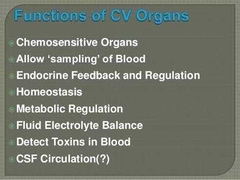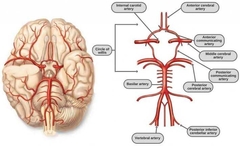![]()
![]()
![]()
Use LEFT and RIGHT arrow keys to navigate between flashcards;
Use UP and DOWN arrow keys to flip the card;
H to show hint;
A reads text to speech;
19 Cards in this Set
- Front
- Back
- 3rd side (hint)
|
Bifurcation of common carotid artery occurs at |
Level of C4 vertebrae |
|
|
|
Division of courses of internal carotid artery |
Cervical part Petrous part Cavernous part Cerebral part |
|
|
|
Explain the course of internal carotid artery |
From point of origin - through carotid sheath in cervical region- through carotid canal in petrous part - enters cavernous sinus through foramen lacerum - at the anterior end of cavernous sinus it enters through the sub arachnoid space |
|
|
|
Branches of cerebral part of internal carotid artery |
Ophthalmic artery Anterior choroidal artery Anterior cerebral artery Middle cerebral artery Posterior communicating artery |
|
|
|
What is the origin of vertebral artery? |
Subclavian artery |
|
|
|
According to the course of vertebral artery, what are the parts of vertebral artery |
Cervical Vertebral Suboccipital Cerebral |
|
|
|
Explain the course of vertebral artery |
From the point of origin - Till entering foramen transversarium - through the 6 cervical vertebrae - horizontal part in suboccipital triangle - enter cranial cavity through foramen magnum - artery lies in subarachnoid space lateral to medulla |
|
|
|
Branches of cerebral part of vertebral artery |
Anterior spinal Posterior spinal Posterior inferior cerebellar Medullary Meningeal |
|
|
|
The two vertebral artery unite to form |
Basilar artery |
|
|
|
Branches of basilar artery |
Anterior inferior cerebellar artery Labyrinthine artery Pontine artery Superior cerebellar artery Posterior cerebral artery |
PSPLA |
|
|
Location and shape of circle of willis |
Interpeduncular cistern and polygonal |
|
|
|
Extent of circle of willis |
Superior border of pons to median longitudinal fissure |
|
|
|
Functional importance of circle of Willis |
1. Equalizes pressure of blood flow on the two side of brain 2. It provides alternative route through which blood entering ica or basilar artery reach the cerebral hemisphere |
|
|
|
What are circumventricular organs |
Areas in the brain devoid of blood brain barrier |
|
|
|
List the circumventricular organs |
Pineal body, neurohypophysis, organum vasculosum of lamina terminal is, median eminence (hypothalamus), subcommissural organ, area postrema |
|
|
|
Function of circumventricular organ |

|
|
|
|
Draw the circle of Willis |

|
|
|
|
Largest subarachnoid cistern |
Cistern magna |
|
|
|
Structure of blood brain barrier |
Endothelial cell Basement membrane Foot process of astrocyte |
|

